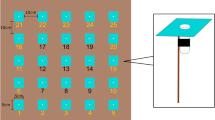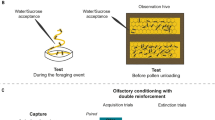Abstract
Transfer of information about food source characteristics within insect societies is essential to colony-foraging success. The food odor communicated within honeybee hives has been shown to be important for food source exploitation. When successful foragers return to the nest and transfer the collected nectar to hive mates through mouth-to-mouth contacts (trophallaxis), potential recruits receiving these samples learn the food odor by associative learning. The food then becomes rapidly distributed among colony members, which is mainly a consequence of the numerous trophallaxes between hive-mates of all ages during food processing. We tested whether the distribution of food among hive mates causes a propagation of olfactory information within the hive. Using the proboscis extension response paradigm, we show that large proportions of bees of the age groups representing the main worker castes, 4 to 9-day-old bees (nurse-aged bees), 12 to 16-day-old bees (food processor-aged bees), and actual foragers (about 17+ day old bees) associatively learn the food odor in the course of processing food that has been collected by only a few foragers. Results further suggest that the information is shared more or less equally between bees of the three age groups. This shows that olfactory information about the flower species exploited by foragers is distributed within the entire colony and is acquired by bees of all age groups, which may influence many behaviors inside and outside the hive.



Similar content being viewed by others
References
Anderson C (2001) The adaptive value of inactive foragers and the scout-recruit system in honey bee (Apis mellifera) colonies. Behav Ecol 12:111–119
Biesmeijer JC, de Vries H (2001) Exploitation of food sources by social insect colonies: a revision of the scout-recruit concept. Behav Ecol Sociobiol 49:89–99
Bitterman ME, Menzel R, Fietz A, Schaefer S (1983) Classical conditioning of proboscis extension in honeybees. J Comp Psychol 97:107–119
Bhagavan S, Bentrar S, Cobey S, Smith BH (1994) Effect of genotype but not of age or caste on olfactory learning performance in the honey bee, Apis mellifera. Anim Behav 48:1357–1369
Breed MD, Perry S, Bjostad LB (2004) Testing the blank slate hypothesis: why honey bee colonies accept young bees. Insectes Soc 51:12–16
Crailsheim K (1998) Trophallactic interactions in the adult honeybee (Apis mellifera L.). Apidologie 29:97–112
Dall SRX, Giraldeau LA, Olsson O, McNamara JM, Stephens DW (2005) Information and its use by animals in evolutionary ecology. TREE 20:187–193
Dechaume-Moncharmont FX, Dornhaus A, Houston AI, McNamara JM, Collins EJ, Franks NR (2005) The hidden cost of information in collective foraging. Proc R Soc Lond B 272:1689–1695
DeGrandi-Hoffman G, Hagler J (2000) The flow of incoming nectar through a honey bee (Apis mellifera L.) colony as revealed by a protein marker. Insectes Soc 47:302–306
De Marco RJ, Farina WM (2003) Trophallaxis in forager honeybees (Apis mellifera): resource uncertainty enhances begging contacts? J Comp Physiol A 189:125–134
Farina WM, Wainselboim AJ (2001) Thermographic recordings show that honeybees may receive nectar from foragers even during short trophallactic contacts. Insectes Soc 48:360–362
Farina WM, Wainselboim AJ (2005) Trophallaxis within the dancing context: a behavioral and thermographic analysis in honeybees. Apidologie 36:43–47
Farina WM, Grüter C, Diaz PC (2005) Social learning of floral odours inside the honeybee hive. Proc R Soc Lond B 272:1923–1928
Free JB (1969) Influence of odour of a honeybee colonies food stores on behaviour of its foragers. Nature 222:778
Galizia CG, Kunze J, Gumbert A, Borg-Karlson A, Sachse S, Markl C, Menzel R (2004) Relationship of visual and olfactory signal parameters in a food-deceptive flower mimicry system. Behav Ecol 16:159–168
Gerber B, Gerberzahn N, Hellstern F, Klein J, Kowalsky O, Wustenberg D, Menzel R (1996) Honey bees transfer olfactory memories established during flower visits to a proboscis extension paradigm in the laboratory. Anim Behav 52:1079–1085
Gil M, De Marco RJ (2005) Olfactory learning by means of trophallaxis in Apis mellifera. J Exp Biol 208:671–680
Giurfa M, Núñez J, Backhaus W (1994) Odour and colour information in the foraging choice behaviour of the honeybee. J Comp Physiol A 175:773–779
Goyret J, Farina WM (2005a) Trophallactic chains in honeybees: a quantitative approach of the nectar circulation amongst workers. Apidologie 36:595–600
Goyret J, Farina WM (2005b) Non-random nectar unloading interactions between foragers and their receivers in the honeybee hive. Naturwissenschaften 92:440–443
Grafen A, Hails R (2002) Modern statistics for the life sciences, Oxford University Press, Oxford
Johnson DL (1967) Communication among honey bees with field experience. Anim Behav 15:487–492
Knudsen JT, Tollsten L, Bergström LG (1993) Floral scents: a checklist of volatile compounds isolated by head-space techniques. Phytochemistry 33:253–280
Kuwabara M (1957) Bildung des bedingten Reflexes von Pavlovs Typus bei der Honigbiene, Apis mellifera. J Fac Sci Hokkaido Univ Ser VI Zool 13:458–464
Ichikawa N, Sasaki M (2003) Importance of social stimuli for the development of learning capability in honeybees. Appl Entomol Zool 38(2):203–209
Laloi D, Gallois M, Roger B, Pham-Delègue MH (2001) Changes with age in olfactory conditioning performance of worker honey bees (Apis mellifera). Apidologie 32:231–242
Lindauer M (1952) Ein Beitrag zur Frage der Arbeitsteilung im Bienenstaat. Z vgl Physiol 34:299–345
Menzel R (1999) Memory dynamics in the honeybee. J Comp Physiol A 185:323–340
Menzel R, Greggers U, Hammer M (1993) Functional organization of appetitive learning and memory in a generalist pollinator, the honey bee. In: Papaj D, Lewis AC (eds) Insect Learning: Ecological and Evolutionary Perspectives. Chapman & Hall, New York, pp. 79–125
Nixon HL, Ribbands CR (1952) Food transmission within the honeybee community. Proc R Soc Lond B 140:43–50
Pankiw T, Nelson M, Page RE, Fondrk MK (2004) The communal crop: modulation of sucrose response thresholds of pre-foraging honey bees with incoming nectar quality. Behav Ecol Sociobiol 55:286–292
Pelz C, Gerber B, Menzel R (1997) Odorant intensity as a determinant for olfactory conditioning in honeybees: roles in discrimination, overshadowing and memory consolidation. J Exp Biol 200:837–847
Pírez N, Farina WM (2004) Nectar-receiver behavior in relation to the reward rate experienced by foraging honeybees. Behav Ecol Sociobiol 55:574–582
Ratnieks FLW, Anderson C (1999) Task partitioning in insect societies. Insectes Soc 46:95–108
Ray S, Ferneyhough B (1997) Seasonal variation of proboscis extension reflex conditioning in the honey bee (Apis mellifera). J Apic Res 36:108–110
Reinhard J, Srinivasan MV, Zhang SW (2004) Olfaction: scent-triggered navigation in honeybees. Nature 427:411
Rösch GA (1925) Untersuchungen über die Arbeitsteilung im Bienenstaat. Z vgl Physiol 2:571–631
Sandoz JC, Laloi D, Odoux JF, Pham-Delegue MH (2000) Olfactory information transfer in the honeybee: compared efficiency of classical conditioning and early exposure. Anim Behav 59:1025–1034
Scheiner R, Page RE, Erber J (2004) Sucrose responsiveness and behavioural plasticity in honey bees (Apis mellifera). Apidologie 35:133–142
Seeley TD (1982) Adaptive significance of the age polyethism schedule in honeybee colonies. Behav Ecol Sociobiol 11:287–293
Seeley TD (1995) The wisdom of the hive: the social physiology of honey bee colonies. Harvard University Press, Cambridge, Massachusetts
Seeley TD,·Kühnholz S, A Weidenmüller (1996) The honey bee’s tremble dance stimulates additional bees to function as nectar receivers. Behav Ecol Sociobiol 39:419–427
Smith BH (1991) The olfactory memory of the honeybee Apis mellifera. J Exp Biol 161:367–382
Sokal R, Rohlf F (1981) Biometry, 2nd edn. Freeman, New York
von Frisch K (1923) Über die Sprache der Bienen. Zool JB Physiol 40:1–186
von Frisch K (1967) The dance language and orientation of honeybees. Harvard University Press, Cambridge, Massachusetts
Wenner AM, Wells PH, Johnson DL (1969) Honey bee recruitment to food sources: olfaction or language? Science 164:84–86
Wilson EO (1971) The insect societies. Harvard University Press, Cambridge, Massachusetts
Acknowledgements
We are deeply indebted to A. Arenas for much thoughtful advice and support during the experiment and I. Hamilton and two anonymous referees for helpful comments on earlier versions of the manuscript. We also thank A. Arenas, and H. Verna for technical assistance. This study was supported by funds from ANPCYT (01-12319), CONICET (02049) and University of Buenos Aires (X 036) to WMF. CG is supported by the VDRB, Commission for travelgrants of the SANW, Dr. De Giacomi Stiftung, Basler Stiftung für biologische Forschung. When we carried out our experiments, we adhered to the legal requirements of the country.
Author information
Authors and Affiliations
Corresponding author
Additional information
Communicated by M. Giurfa
Rights and permissions
About this article
Cite this article
Grüter, C., Acosta, L.E. & Farina, W.M. Propagation of olfactory information within the honeybee hive. Behav Ecol Sociobiol 60, 707–715 (2006). https://doi.org/10.1007/s00265-006-0214-0
Received:
Revised:
Accepted:
Published:
Issue Date:
DOI: https://doi.org/10.1007/s00265-006-0214-0




